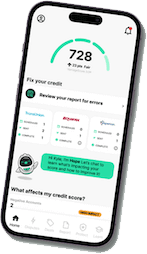Understanding a 611 Credit Score: What It Means and How to Improve It

A 611 credit score falls in the “fair” range but below the national average, affecting your access to favorable financial opportunities. This guide explains the causes of a 611 score, how it impacts areas like loans, insurance, and credit cards, and practical steps to improve it—from lowering credit utilization to diversifying your credit mix. With Dovly’s automated credit optimization platform, you can simplify credit management and work toward a healthier financial future.
Your credit score is more than just a number—it’s a key that can unlock financial opportunities or keep them out of reach. A 611 credit score is below the national average credit score and may limit your access to favorable loan terms, but it’s far from the end of the road. In this guide, we’ll break down what a 611 credit score means, how your credit score impacts your financial health, and actionable steps to improve your credit score. If you’re ready to take charge of your credit, Dovly is here to help.
What is a 611 Credit Score?
A 611 credit score is in the lower end of the “fair” range for both FICO and VantageScore. You may have multiple credit scores from different credit bureaus which can vary slightly. This credit score is not in the “poor” range but is below the national average which is currently around 700. Unlike a poor credit score, a 611 credit score means there’s room for improvement but also an opportunity to build and grow your credit.
What Causes a 611 Credit Score
- Missed or late payments on credit accounts
- High credit card balances
- Limited or short credit history
- Negative marks such as collections or charge-offs
- Identity theft or errors on your credit report
What 611 Credit Score Means for You
Employment
Some employers pull credit reports for jobs that involve financial responsibility. A 611 credit score may raise concerns but not a sole disqualifier.
Insurance
Some insurers use credit-based scores to set premiums. A 611 credit score may mean higher insurance rates for auto or home.
Can I Buy a House with 611 Credit Score?
FHA loans are an option for people with fair to poor credit scores as they only require a minimum credit score of 580. Here are some tips to help you:
- Save for a bigger down payment
- Work on paying off existing debt
- Get a co-signer if needed
Also, building credit through good financial habits can improve mortgage options over time.
Other Mortgage Options:
- VA Loans: If eligible, VA loans have no minimum credit score requirement.
- USDA Loans: Rural development loans may have flexible credit score requirements
Credit Cards
Your credit card options may be limited but there are still some options to help you build credit:
- Secured Credit Cards: These cards require a security deposit which becomes your credit limit. They are great for building or rebuilding credit as your payment history is reported to the credit bureaus. OpenSky is a great option!
- Store Credit Cards: Offered by retailers, these cards may have higher interest rates and fees but are easier to get with poor credit. They can help you build credit if you make regular, on-time payments.
- Credit-Builder Credit Cards: For people with lower credit, these cards have lower limits and higher interest rates but can be a good starting point.
Understanding Your Score
What Affects Your Score
Credit scores are made up of several factors, each weighted differently. These are the main factors that are used in calculating credit scores:
- Payment History (35%): Missed or late payments will hurt your score.
- Credit Utilization (30%): How much credit you’re using compared to your limits. High utilization will lower your score.
- Length of Credit History (15%): Longer credit history will help boost your score.
- Credit Mix (10%): Having a variety of credit types (e.g., credit cards, loans) will help your score.
- New Credit (10%): Applying for multiple credit accounts in a short period will lower your score due to hard inquiries.
With this understanding, you’re empowered to take steps to improve your credit score.
Credit Score Ranges and Percentages
Credit scores range from 300 to 850, higher is better:
- Excellent (750-850): 21% of people; great loan terms.
- Good (700-749): 18% of people; good terms.
- Fair (650-699): 15% of people; moderate risk, higher interest.
- Poor (600-649): 12% of people; hard to get credit.
- Bad (Below 600): 34% of people; limited accessibility and high fees.
Now you know your score, now you can check your health.
How long to improve a 611 credit score?
Credit score improvement timeframes will vary based on what you do and what’s holding you back. Minor tweaks like paying off credit card debt can show up in a few months. Correcting negative marks or establishing new credit will take longer.
7 Steps to Improve Credit
1. Get Your Credit Report
Pull your free credit report from AnnualCreditReport.com and review it thoroughly for errors or inaccuracies. Make sure to look for accounts that don’t belong to you, outdated info or late payments that were marked wrong. By removing errors you’ll see a big jump in your score.
2. Lower Your Credit Utilization
Reducing your outstanding balances on your credit card accounts can make a big difference. Here’s how to lower your credit utilization:
- Pay down credit card debt: Focus on paying off high interest credit cards first to reduce your overall utilization. If you can’t pay them off right away, try to get your balance below 30% of your available credit.
- Ask for a credit limit increase: Contact your credit card issuer and ask for a limit increase. By increasing your available credit without increasing your balance, you can lower your utilization ratio and improve your credit score. Just don’t go out and spend more after the increase.
3. Pay on Time
Payment history is the biggest factor in your credit score, accounting for 35%. Late payments can stay on your report for up to 7 years, hurting your credit score. Here’s how to help you pay on time:
- Set reminders or autopay: Use a digital calendar or payment reminders so you never miss a payment. Many banks and credit card companies offer autopay options to automatically withdraw the minimum payment which can prevent late fees and missed payments.
4. Limit Hard Inquiries
Every time you apply for new credit the lender will do a hard inquiry. Too many in a short time can hurt your score. Be smart about applying for new credit and only apply for accounts you really need.
5. Diversify Credit
A varied credit mix (credit cards, installment loans, retail accounts) can help your credit score. To build a stronger credit profile:
- Open a secured credit card or credit-builder loan: If you don’t have much credit history or your existing credit mix is limited, consider applying for a secured credit card or credit-builder loan. These can help you establish a positive payment history and improve your score over time. Here are some good options for credit builders: Credit Strong (Instal & Max) and Kovo
- **Be careful with new accounts: While diversifying credit is good, opening too many new accounts too quickly can hurt your score. Focus on long term credit building strategies rather than adding several new accounts at once.
6. Pay Debts
If you have debts in collections or charged-off accounts you need to address them. Here’s what you can do:
- Negotiate with creditors: If you have a collection account, reach out to the creditor or collection agency to negotiate a “pay-for-delete” agreement. This involves agreeing to pay off the debt in exchange for the creditor removing the account from your credit report. Be sure to obtain the agreement in writing before making any payments.
- Settle for less: If you can’t pay the full amount see if you can settle for less than the original amount owed. Some creditors may forgive a portion of the debt in exchange for a lump sum payment.
7. Keep old accounts open
Length of credit history accounts for 15% of your score. The older the accounts the better for your score as it shows lenders you’ve been managing credit for a long time. Even if you’re not using an old credit card or loan, keep the account open and it will increase your average credit age and score.
With these steps you can make a big impact on your 611 credit score. Whether you’re working on credit utilization, paying on time or disputing errors, every step you take gets you closer to a better score and more financial freedom.

How Dovly Can Help
Dovly is more than a credit repair company. Dovly takes the complexity out of credit optimization, offering a fully automated platform that works tirelessly behind the scenes to improve your credit. Our system doesn’t just monitor your credit—it actively manages and optimizes it, using a data-driven approach to tackle issues that may be hurting your score.
Here’s how Dovly can assist you with credit score improvement and beyond:
- Comprehensive Credit Monitoring
- Automated Dispute Resolution
- Smart Alerts and Reminders
- Expert Advice When You Need It
- Ongoing Support and Progress Tracking
Conclusion
A 611 credit score may feel like a barrier, but it’s far from the end of the road. With the right knowledge, effort, and tools, you can turn it into a stepping stone to better financial opportunities. Don’t let a fair credit score hold you back from achieving your goals—whether that’s buying a home, securing a car loan, or getting access to lower interest rates.
Ready to take control of your credit and boost your financial future? Sign up for Dovly today and let our cutting-edge, automated platform do the hard work for you.
Frequently Asked Questions




